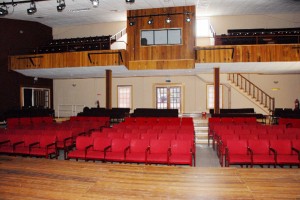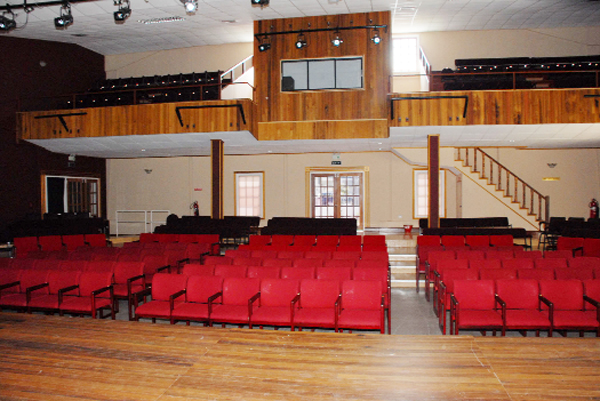At the start who would ever have thought that such a summit might be climbed? There has been nothing in the domain of private and public subscription which equals this. It has not been one or two great patrons who have brought all this about. It has been the multitude of benefactors – corporate, individual, governmental, diplomatic and in the Guyanese diaspora – who have contributed
– Ian McDonald
Nicosia Smith examines the significance of the restoration of Guyana’s best known Playhouse – The Theatre Guild
The eve of Guyana’s hosting of CARIFESTA X coincides with the triumphant conclusion of a labour of love, the completion of a new, modern theatre, a reincarnation of an invaluable treasure.

For over four decades the Theatre Guild Playhouse had come to be synonymous with theatre in Guyana. Its magnificent transformation after a period of depressing decline is a glowing tribute to some of the very people whose passion for drama had been forged in the ‘fires’ of the tiny Kingston Playhouse.
The Theatre Guild Inc was founded in 1957, opened in 1960 and formally incorporated on September 9, 1961.
Age and neglect had, for years, rendered it unusable, a decaying reminder of an earlier time. The archival records of TG Inc states that the decline took place during “the last two decades of the 20th Century.” Many of those whose careers had had their genesis at the Playhouse “would move on to other parts of the Caribbean and the wider world, taking with them the talent nurtured in the TG’s environment,”
Inevitably, the institution “began to dwindle in spite of the efforts and talents of the small group of people who remained committed to the arts in Guyana.”
Between 1994 and 1996 a brief but vain attempt was made to revive the Theatre Guild. At the end of what turned out to be a failed initiative it seemed that the final curtain had indeed fallen on the stage which had incubated much of the artistic talent for which Guyana had come to be known.
Russel Lancaster, a member of the Management Committee of the current restoration initiative has disclosed that it has taken around $85M to refurbish The Guild and to acquire and install the technical equipment housed inside the thoroughly restored structure.
Lancaster recalls that the latest and ultimately successful effort to get TG up and running again came in 2003. Through the Ministry of Culture, Youth and Sport, under the then Minister, Gail Teixeira, a retreat was held in November of that year. It was that retreat that that led to the establishment of an Interim Management Committee. The mandate of the Management Committee was to set up a Board of Trustees, initiate a membership drive and contemplate the various issues associated with the refurbishment of the Theatre.
The energies that spawned the splendid ‘comeback’ of the Theatre Guild were spawned, it seems, purely out of love for the stage and a nostalgic longing for the return of the halcyon days of drama in Guyana. That is what drove Malcolm De Freitas, the serving Vice Chairman of The Guild, who became involved with the rebuilding initiative as far back as 1981.
Serving Playhouse Manager and an early member of The Guild, Diana Abraham, recalls the reason why theatre lovers fell ‘victim’ to the lure of the stage. It was, she says, purely a matter of a compelling love for an enriching pursuit. Of the rebuilding effort, she says: “It’s a lot of work and all of this was done for no pay.”
Daphne Rogers, who became a member of the Theatre Guild in the sixties and who, for a time, was in charge of costumes, retains that responsibility under the contemporary dispensation. She believes that the decline of the Theatre Guild had its roots in an understandable desire among the talented performers of the time to move on with their lives, to migrate and to transform youthful passion into materially rewarding careers.
Abraham agrees. She believes that migration robbed the Theatre of its “whole community of volunteers.”
She herself migrated to Canada during the sixties. Last June she returned home to volunteer for the rebuilding project. Her term as Playhouse Manager comes to an end in September.
Rogers recalls the golden years of the Theatre Guild with a refreshing clarity. “Whenever there (was) a crisis in Guyana we used to come to the theatre Guild and just enjoy,” she says.
Both Rogers and Abraham recall the grand parties that the Playhouse used to stage. It was a way of ensuring that those whose energies fueled the theatre could ‘unwind.’
People have long memories of what the Theatre Guild has done for drama in Guyana and Abraham says that she is encouraged by the keenness of Guyanese in the diaspora to give to the restoration of the tradition spawned by the Theatre Guild.
Rogers, after whom one of the dressing rooms is named, speaks animatedly about the beauty of the new Playhouse, the size of the new stage, the greater comfort afforded by the new seating arrangement, the larger audiences that it can now accommodate and the Bert Carter Balcony – named after another of the faithful volunteers for the rebuilding project.
Abraham is struck by what she believes is an “intimate theatre.” The lighting, she says, is greatly enhanced and the acoustics of a more professionally designed and built structure will significantly enhance the quality of future productions; and the ‘new’ seats, Abraham says, are both examples of creative recycling and a nostalgic concession to the retention of ‘something old’- the balcony chairs are the original ones; the legs have been removed, leaving the cushions and backs in place.
Creative Director OF CARIFESTA X, Dr. Paloma Mohamed-Martin says that the new Playhouse has the most modern lighting and sound facilities anywhere in the Caribbean, for any theatre in the Caribbean. And De Freitas makes a pertinent point about the role of the new Playhouse, that is that the use of the National Cultural Centre as a makeshift theatre does not gainsay the significance of the restoration of the Theatre Guild. A Cultural Centre, he says, is not a theatre and there are limitations to the effectiveness of its use in that manner.
And part of the focus of the new Theatre Guild is to bring a new, more egalitarian focus to theatre in Guyana. “There is a view of it (Theatre Guild) as being elitist,” Abraham says. “Most of us were part of the Guyanese middle class.”
The aim of the new Theatre Guild, she says, is, “to bring in kids and young people from all across Georgetown,” Abraham, in collaboration with a Canadian colleague, has already involved children from the surrounding community. Including children living on the Railway Embankment, by inviting them to visit the Theatre “They had no hesitation,” she said. Abraham explained that part of the exercise involves teaching children how to write plays and how to perform.
Dr. Mohamed, the current Director of Centre for Communication Studies at the University of Guyana became a member of the Theatre Guild during the 1980’s as a student of Queen’s College. The structure of the Board of Management, she says, is made up of people of all walks of like.
Part of the challenge that confronts the new Theatre Guild lies in the rebuilding of a national artistic inventory that has become diminished with time. “We need members from a whole lot of backgrounds including retirees,interested in working with children,” Abraham says.
Finances
The Guild remains a non-profit organization that relies on volunteerism. Goodwill, however, will hardly be sufficient to sustain the institution. During its first incarnation in the sixties the Guild charged its members a subscription fee of $200.00 per year. Its much more modern infrastructure will prove far more costly to maintain and new and innovative ways must be sought to secure a sustained flow of funding.
Abraham says that with its enhanced accommodation the facility can now be rented to professional theatre houses and can also be used for other events such as public lectures.
Help in ensuring the preservation of the new Theatre Guild is already being offered by several persons and institutions. Beyond 2000, a Regent street business enterprise has already agreed to trim the lawns of the Playhouse for one year. Precision Woodworking, which has already donated the tables for the bar, has also agreed to make a further donation of a number of outdoor umbrellas.
No one seems to doubt that the new facility will be far more expensive to maintain and that the its effective management must include the generating of funds. Electricity bills will prove a major challenge. Electricity costs are now much higher than they were in previous years and the new Theatre Guild is equipped with air conditioning. The new Theatre Guild has hit the ground, running. Workshops for actors, playwrights and directors are already planned. Two months ago a technical programme for more than 600 participants between the ages of 15 was initiated.
The purpose of the programme is to hone creative skills some of which will be on show during CARIFESTA X.
Part of the plan for the immediate future is to use the new Theatre Guild to stage a Playwrights’ Festival, a means through which, it is hoped, the art of creating theatrical productions will be rekindled. And while the rechristening of the Theatre Guild is set to coincide with CARIFESTA X, its rise, like a phoenix from the ashes, marks a new and exciting chapter in the rich history of theatre in Guyana.

